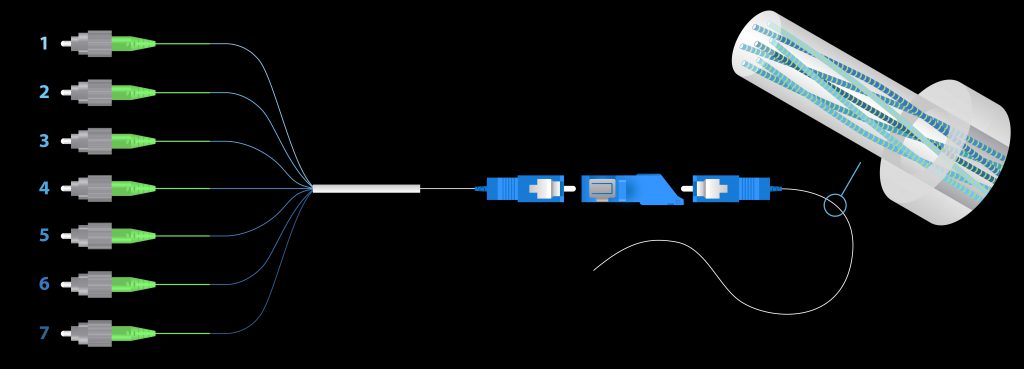Optical Fibers Illuminate Brain Activity
Leave a Comment
Medical imaging faces limitations inherent to its mode of presentation. While computer models and virtual reality are much more effective than 2D depictions, the result continues to be still images on a computer screen. Even with stereoscopic techniques, a user’s ability to visualize the result can depend on using a keyboard or mouse to interpret the model. And, with 4D experimental medical data (such as MRI), objects are displayed as computer animations or static pictures.
A recent Biophotonics article by Thomas Britton and OFS’ Jaehan Kim shows how a hands-on, 3D-printed brain model equipped with optical fibers can help clinicians and patients to visualize brain function activity while avoiding the shortcomings of 4D neuroimaging techniques.
To access the full article, please click HERE.
OFS Launches New Shape Sensor Fiber at BIOS/Photonics West
Leave a Comment
OFS will showcase its new Shape Sensor Fiber at the BIOS/Photonics West Exposition in San Francisco, January 28-February 2, 2017.
To create the Shape Sensor Fiber, OFS developed a technology platform to produce high-quality, twisted multicore optical fiber with continuous Fiber Bragg Gratings (FBGs). This type of fiber with FBGs provides stable and good signal-to-noise ratio throughout the fiber length and ease of use to customers. The manufacturing platform also allows OFS to customize and optimize the fiber to meet various customer demands more economically. In addition, OFS also offers low back reflection distal termination, multicore connectorization and fan-outs to support customer demand.
Many medical device companies are developing cutting-edge endoscopes, catheters and other equipment with shape sensing technology to increase the quality of patient care. By embedding or surface-attaching the fiber to surgical tools or other devices, technicians can calculate and reconstruct the 3D shape of an instrument on a display screen. By allowing users to monitor the exact shape and position of the instrument, physicians can conduct minimally invasive surgery (MIS) or treatment which generally results in shorter recovery times, less pain and trauma, reduced rates of infection and shorter hospital stays.
Learn more about OFS Fiber Optic Sensors
OFS Showcases Award-Winning, Next-Generation Multimode Fiber
Leave a Comment
 Data centers and enterprise networks continue to require ever-increasing speeds. Yesterday’s 10 Gbps networks are rapidly being replaced by 40 and 100 Gbps speeds, and 400 Gbps networks are on the horizon. How can today’s network designers best support this increasing demand for bandwidth?
Data centers and enterprise networks continue to require ever-increasing speeds. Yesterday’s 10 Gbps networks are rapidly being replaced by 40 and 100 Gbps speeds, and 400 Gbps networks are on the horizon. How can today’s network designers best support this increasing demand for bandwidth?
TIA has standardized a new multimode fiber to support short wavelength division multiplexing (SWDM). Referred to in the industry as “wideband” multimode optical fiber, this new fiber type extends the ability of conventional OM4 fiber to support multiple wavelengths. Wideband optical fiber will also maintain the cost advantages of multimode fiber for short-distance applications by supporting duplex fiber links at speeds up to 100 Gbps and 400 Gbps eight-fiber links.
At the BICSI Winter Conference this week, OFS is showcasing its award-winning LaserWave® FLEX WideBand Multimode Optical Fiber. This fiber is designed to support today’s high speed 850 nm-based systems and tomorrow’s multi-wavelength systems. Optimized for SWDM, OFS WideBand Optical Fiber is the best choice for short-reach enterprise and data center applications.
For the latest WHITE PAPER on LaserWave FLEX WideBand Optical Fiber, please go here. Also be sure to visit OFS in booth 614 at the BICSI Winter Conference (January 22-26-2017 – Tampa, FL).
Fueling the Next Information Revolution
Leave a Comment
Silicon photonics technology is coming to market at a time of momentous change for Internet content providers, data centers, chip and optical components manufacturers and telecom service providers.
In fact, silicon photonics (SiP) is set to change a number of these industries, as a new book co-authored by Daryl Inniss of OFS explains. Silicon Photonics: Fueling the New Information Revolution outlines the history of SiP development along with the many roles that this technology will play in the future.
The authors cover key topics including the latest research assessing SiP development and prospects; how SiP addresses the challenges of managing bandwidth over distances and within systems; and potential applications of SiP, including servers, data centers and the Internet of Things (IOT).
To read and learn more about this book, click here.

